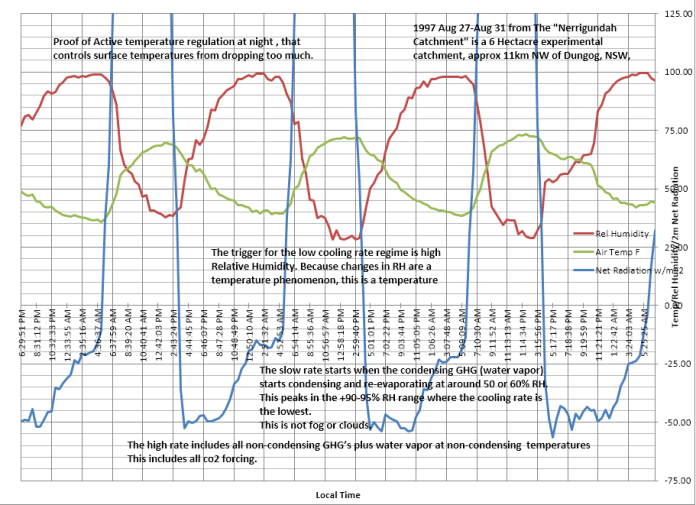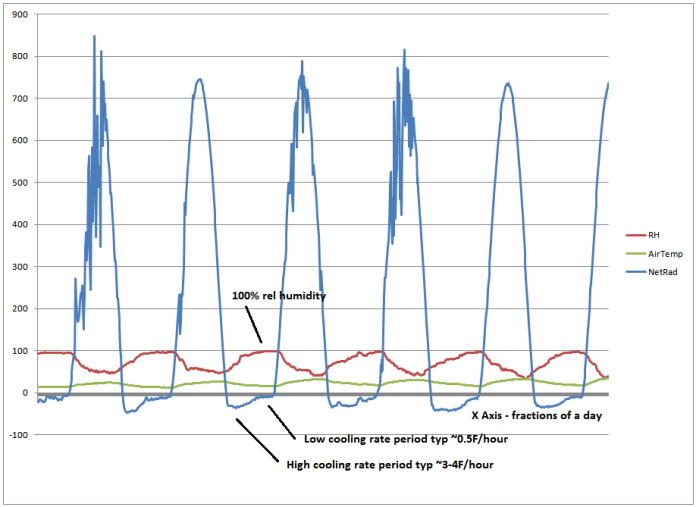An analysis of nightly cooling has identified non-linearity in cooling rates under clear sky no wind conditions that is not due to equilibrium with the with the radiative temperature of the sky. This non-linearity regulates surface temperature cooling at night, and is temperature and dew point dependent, not co2, and in fact any additional warming from Co2 has to be lost to space, before the change to the slower cooling rate.
Nightly data with min temps following dew point temp.
Just under 60 million surface station measurements from around the world showing min temp following dew point.
Night time cooling is nonlinear, at sunset the cooling rate is very high, this is the regime controlled by co2, but later in the night, as air Temps near dew point, cooling greatly slows, this is the regime controlled by water vapor. The thing is, even if there is a slight warming from co2, that heat is lost to space prior to the switch to the low cooling rate water vapor controlled regime(because the switch is temp controlled). Water vapor controls cooling, not co2. Consider deserts and tropics as the 2 extreme examples, deserts, mostly co2 limited cooling drop on average of 35F in a night, there tropics controlled by water drop on average 15F at night. Lastly the only way co2 can affect Temps is to reduce night time cooling, it doesn’t.
I finally found another Scientist looking at cooling, and they found that cooling was exponential. After exchanging messages, he send me the link to the data they collected, and in it had weather and solar, I looked at a few sample clusters of days, and found what I was looking for.
This is part of 6 days. But the key data is the NetRad, note how during the night at the same time rel humidity nears 100%, net radiation drops by 2/3rds. This data covers at least 2 clear days, and the other days are mostly clear. There are many examples of this.
This is the evidence that supports my theory that water vapor regulated nightly cooling, and co2 doesn’t do anything.
Increasing relative humidity is the temperature regulation of nightly cooling, not co2.
Here is the same date, just a closer view.

The effects of a 2 state cooling rate(4F/hour, 1F/hour), both starting at 75/77F One with a 60F dew point, the other a 50F dew point.
Both examples converge to the same final temp.
If we could see this invisible process I think we’d see something like this
2. Variations of Radiation is only a part of the Climate Change PhysicsInternal mechanisms of the global energy budget such as evaporation-condensation and deep global ocean current variations also play an independent role from radiation as a major climate change mechanism (Figure 3). The whole AGW theory and dialog over the years has been based on radiation changes. This is far too narrow and naïve.
ftp://ftp.ncdc.noaa.gov/pub/data/gsod/
Code and reports (chart source data):
http://sourceforge.net/projects/gsod-rpts/




What I would like to see would be just a graph of the heat content of the atmosphere at the reporting stations. I think that as the RH changes as the temperature rises or drops the actual heat content will not change that much. You see this as the temperature drop flattens in evenings. If the heat content of mist droplets and clouds is included I suspect that heat content will be far more constant than expected.
LikeLike
I have that in my data set, but it didn’t really change the results all that much, the squiggles were very similar. If you haven’t, follow my name to my page, there’s a lot of interesting stuff there, plus if you want that data to draw your own graph, there is a link to it. My intention was to produce data for others to use, as a foil to all of the adjustments in all of the other series, my data would fall into the “organic” category, compared to BEST, CRU, GISS, etc
LikeLike
I see you made it here, so this is the link, it was on another page http://sourceforge.net/projects/gsod-rpts/
LikeLike
At my sourceforge.net report page (listed under the Not co2 page) The Beta 3 data has enthalpy min, max, etc.
LikeLike
Hello,
What you have researched looks very interesting. I would be very grateful if you would respond to me by email. cosserat@gmail.com
Best regards
David
LikeLike
You forgot to include this graph: https://pbs.twimg.com/media/C7qn6rMVAAEqMmP.jpg:large
LikeLike
What an astonishing difference between the BE monthly data

And your daily data…
LikeLike
That’s because I do it wrong (ask Mosh, he’ll tell you) I show you what was measured
LikeLike
Wow, I am generally familiar with Steven’s, and Zeke’s and Nick’s arguments @ TOD bias, and am unable to find any objection. TOD adjustment is trivial compared with the difference between zero trend in daily highs, and a huge trend. I’ll ask Steven to explain.
LikeLike